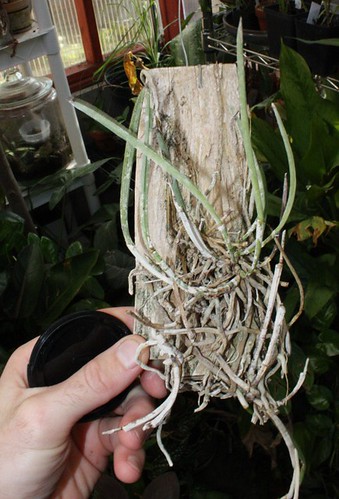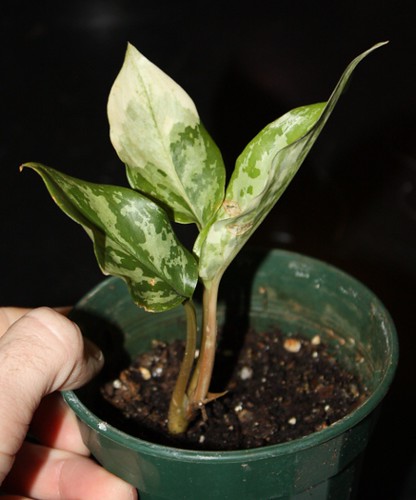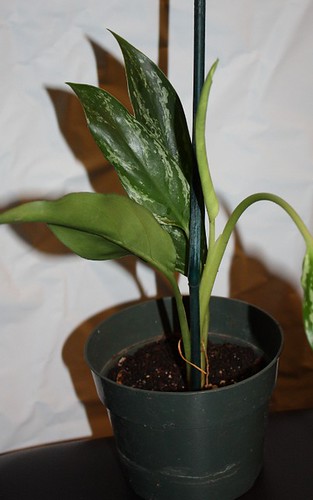I have a number of mounted orchids in my collection now, so I thought I would post about those orchids specifically, even if some of them have been shared before.
 |
| Dockrillia cucumerina - back when I first got it. |
The first is my "cucumber" orchid,
Dockrillia cucumeria, which I
purchased in February. It started to get crispy outside in our scorching 100+ days from June to August. I brought it inside, where it seemed to be happier, but it couldn't recover from the heat, and eventually died. I am finding that the mounted orchids (not surprisingly) dry out more quickly than the potted orchids. This is good and bad. It is more similar to the natural habitats of epiphytic orchids, but it also requires that I stay on top of watering. With these mounted orchids inside, it is pretty easy to do. I have been keeping a couple of these hanging in the bathroom window and the kitchen window, where sinks are readily available and where I am seeing them several times a day. I will try to obtain another of these little cucumbers, because it really was a favorite of mine.
 |
| Dendrobium lichenastrum var. prenticei mounted on cork bark |
I have one other of these small, succulent type orchids,
Dendrobium lichenastrum v. prenticei. This one is also mounted on a piece of small cork bark. Where as the previous plant looked like little cucumbers, this one is smooth and has yellow flowers when it blooms. So far it has been doing well in our kitchen window, with about 5 other mounted orchids. I see this constantly and water them when I am washing dishes.
 |
| Dendrobium pachyphyllum |
My
Dendrobium pachyphyllum is a new addition that is mounted on a compressed fern slab. This stringy glob of orchid won me over on three accounts: 1. It has that stringy, "don't try to tame me" look. 2. It is kind of woody, which has a permanence and toughness that I really like. 3. It's a
Dendrobium species. While
Dendrobiums are one of the more common orchids you can find (2nd to Phalaenopsis in terms of grocery store prominence), there is a HUGE variety of
Dendrobiums and I am collecting some of the more obscure ones. The flowers of this
Dendrobium are discrete little short-lived light pink blooms that come along the stems all over the plant - a prolific bloomer. They are supposed to smell sweet.
 |
| Encyclia polybulbon - photographed in April, when I first got the plant |
These next two plants (above and below) were the
first mounted orchids I purchased. Both are mounted on a simple slat of wood, with sphagnum moss wrapped around the roots. The plant above is the first
Encyclia in my collection. It hasn't bloomed yet, but it has been growing steadily this summer and I understand that it blooms from fall to early spring. So I am hoping to keep it happy in the coming months and be rewarded with the first blooms.
 |
| Sedirea japonica - photographed in April, when I first got the plant |
This is one of the few fragrant orchids in my collection.
Sedirea japonica is noted for it's really unique small white blooms with purple bars. These blooms tend to hang below the plant and are supposed to smell amazing. My plant didn't bloom this summer when it should have, so I am hoping for a bloom next year.
 |
| Panarica brassavolae |
The genus
Panarica is closely related to (often tagged as)
Encyclia. So I actually bought this plant with the name
Encyclia brassavolae. This one is mounted on a heavy and thick piece of wood that the seller called a "cedar plaque." There is some media that might be coconut fiber/husk or something like that, so that some water can be absorbed and held near the roots whenever I water this one. I might have to modify this and add some sphagnum moss since I suspect my humidity is too low to keep the plant happy with this mount. The flowers of this species are really cool. Picture an anorexic yellow starfish wearing a white hat with a pink feather in it. Or just look at
this picture and make up your own analogy.
 |
| Bulbophyllum clandestinum 'Elizabeth' |
The plant pictured above was on my want list for a while. I kept seeing really nice specimen-sized (large) plants available on eBay and they would go for big bucks (>$40). I held out until I got a smaller plant for about $10. This is a neat plant because of how it wanders and the blooms are born all along the creeping rhizome, unlike most
Bulbophyllums which have long blooms spikes with lots of blooms clustered together. I also like the woody look of the stems. My plant is a collection of 2 or 3 cuttings tied to a twig raft.
 |
| Brassavola nodosa. That chalky appearance is fertilizer build-up from the previous owner. |
The orchid pictured above was actually collected in the jungles of Belize years ago (when it was legal to do such things). It is a common orchid among collectors,
Brassavola nodosa and is mounted on a slab of cypress wood.
 |
| Cattleya hybrid (Catt. John Hannington x Catt. Empress Bells 'White Sands') - self mount |
This
Cattleya pictured above is the one orchid I have which I mounted myself. I received the orchid as a gift when I joined the Oklahoma Orchid Society. It was a tiny little plant. To be honest, I'm not a big
Cattleya guy myself. It was a little plant and I had a piece of drift wood that I wasn't using, so I thought, "What they heck! Let me give it a try." It has been doing pretty well on the driftwood. It survived our scorching summer heat, so that's a good sign.
 |
| Encyclia tampensis |
While we were in Florida, I was on a mission to purchase some
Encyclias, especially the well-known Florida-native "Butterfly Orchid",
Encyclia tampensis. I saw many of these growing wild in the Everglades and then I found a really nice one mounted on tree fern at
Ruben in Orchids. It looks as though it had bloomed on at least 3 different spikes recently and it was well rooted into the mount.
 |
| Encyclia randii |
A good friend of mine attended the recent American Orchid Society show in San Antonio at the end of October. While he was there, he scoped out the available stock of orchids and aroids and sent me some information on plants I like to grow. He was generous enough to purchase two
Encyclias for me and drop them by my house on his way home to Arkansas. Both of these little
Encyclias are fragrant when in bloom and mounted on little wood planks by Oak Hill Gardens - one of my favorite orchid sellers.
 |
| Encyclia cordigera |
About a month ago my parents-in-law returned from a trip with a couple of orchids for me and one that my mother-in-law was keeping for herself (or so I thought). In actuality, she was keeping the last orchid for my birthday. But she showed it to me at the time - in bloom - and held on to it until my birthday to give it to me. I'm glad I took a nice picture of it in bloom at the time! This is a really neat TINY hybrid with the name
Ornithocephalis iridifolius x Zygostatus alleniana. That "iridifolius" part means that the foliage looks like an iris. It has that characteristic fan appearance, but on a very tiny scale.
 |
| Ornithocephalis iridifolius x Zygostatus alleniana mounted on cork bark - photo taken about a month ago. |
 |
| Maxillaria variabilis mounted on native bark |
Jason gave me a division of his
Maxillaria variabilis a couple months back. I decided to try mounting it on a section of bark I had from a local tree. I don't know of anyone doing this. My guess is that the people don't do it because you need a really durable bark that won't break down over time, so there are only a few options available. This mount will probably not last a long time, but it's worth a shot, in my opinion. For now, the orchid is just laying on top of the bark, with a wad of sphagnum moss on top of the roots. Hopefully in a couple of months the roots will have bitten into the bark. My favorite thing about this little orchid? It has been blooming non-stop, since I got it.
 |
| Dendrochilum stenophyllum mounted on PVC |
Now we make it to the fifteenth and final mounted orchid in my collection. Last, but certainly not least. This is
Dendrochilum stenophyllum, one of the "chain orchids." According to the wikipedia page, "These orchids are popular among fans of non-traditional orchid curiosities." I guess that sums up my interest, huh? Anyway, this species is notable for it's very grass-like foliage and it's miniscule flowers which grow on a stem about the length of the leaves. My plant is mounted on a piece of canvas wrapped around a section of PVC pipe. I think it's a curious mounting system. The really good part is that the PVC holds up over time and won't be slowly breaking down. However, the canvas has long since broken down, leaving the PVC very exposed. I don't mind the white showing, but I might try to cover it up at some point in the future.




















